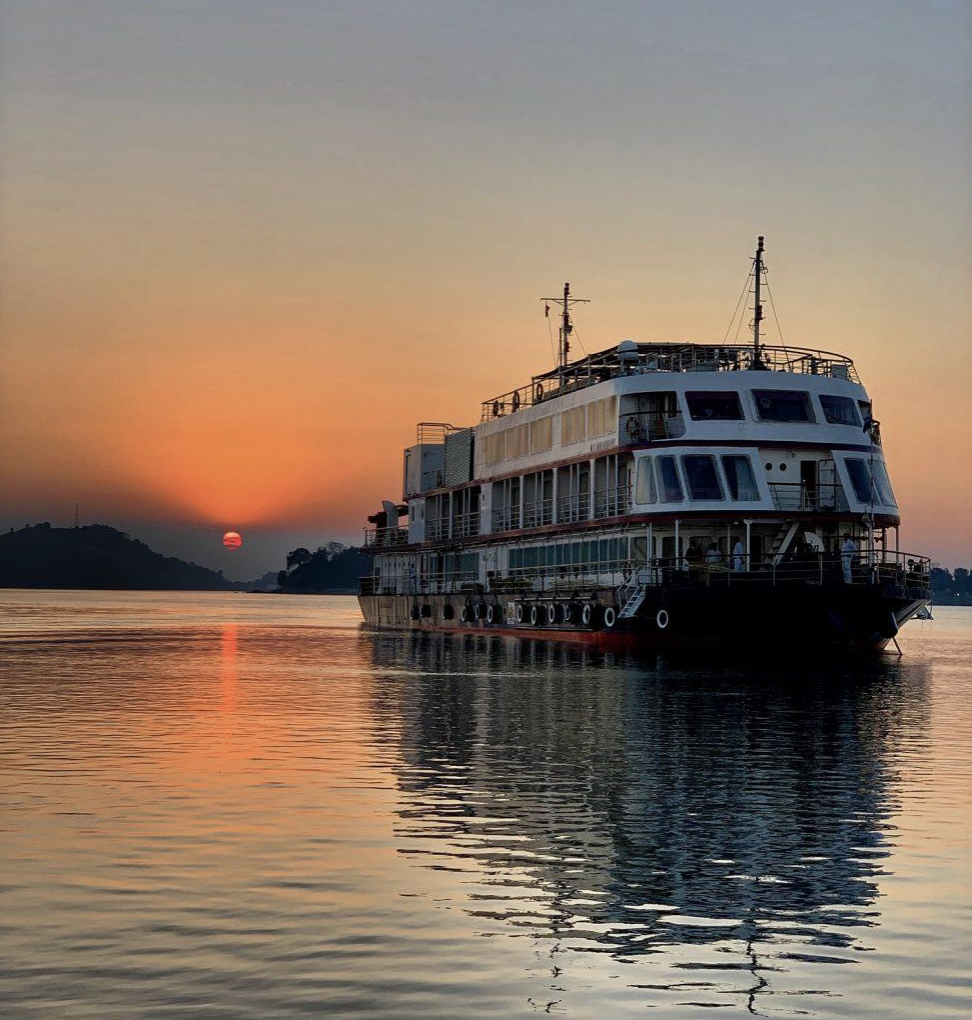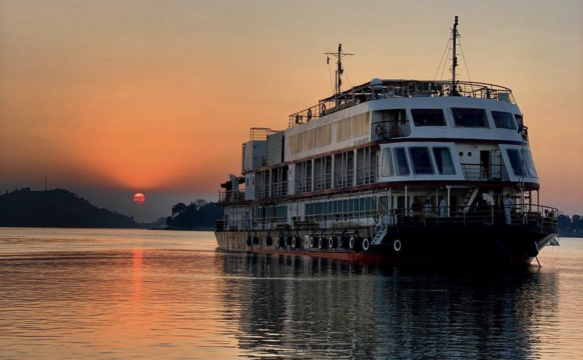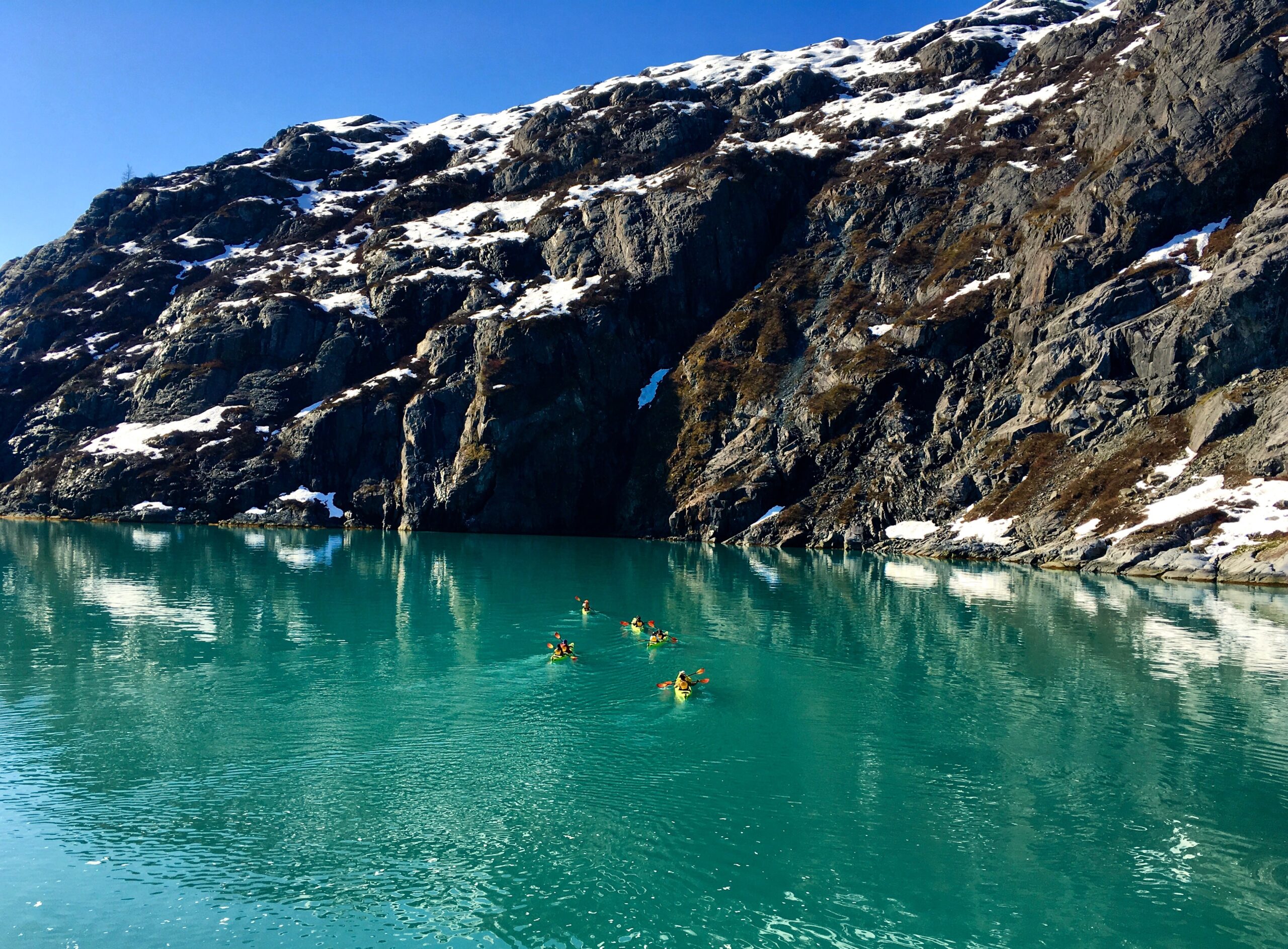Our small ship cruise on the Brahmaputra River in Assam, northeast India, began in Guwahati. During our transfer from the airport to the M.V. Mahabaahu, we stopped briefly at the Hindu Kamakhya Temple, a sacred site where according to legend, the gods Sati and Shiva met. As a result, this temple holds special significance for followers of Tantra and the esoteric traditions of Hinduism and Buddhism.
Embarkation in Guwahati, India

Almost immediately after setting sail, we stopped at a tiny, tree-covered island known as Peacock Island. A small temple was present but there were no human inhabitants. Instead, we were greeted by a surprisingly outgoing Golden Langur monkey that came down from the trees to pose for photos —a memorable start to our Brahmaputra River cruise.
Our first golden sunset was an especially delightful way to begin our Brahmaputra adventure.

Day 2: Bangla Village
We explored a Bangla Muslim farming village in Upera. We walked through fields of vibrant yellow mustard seed flowers and cabbages.
The young children were excited to welcome us to their village, awaiting our arrival on the sandy banks of the Brahmaputra River. After taking photographs with their permission, we shared the images with the children and enjoyed looking at them together.
Day 3: A Foggy Day of Cruising on the Brahmaputra River
Our third day became a relaxing sea day due to unexpectedly foggy conditions. With fog only occurring 19 days each season, we were fortunate to experience this and
welcomed the downtime to relax. Consequently, I took advantage of my free time to experience a two-hour Ayurvedic massage for the first time. This was a unique experience, with the Ayurvedic holistic techniques focussing on relieving physical and emotional stress.
Day 4: Kaziranga National Park– UNESCO World Heritage Site
Elephant-Back Safari & Jeep Safari
The Brahmaputra is no ordinary river and is a destination unto itself. It is the only river apart from the Zambezi in Africa with direct access to a game reserve. Kaziranga National Park is a UNESCO World Heritage site. It is referred to as “the Serengeti of India” by National Geographic.
The 430-square-mile park is home to the endangered one-horned white rhinoceros. Park attendants informed us that poachers hunt these endangered rhinos. A controversial “shoot-to-kill” policy is in place if the rangers discover poachers.
We were up at 3 am, anxious to begin our day in four-wheel drive vehicles headed to Kaziranga National Park for an elephant-back safari experience. The mist was rising from the grass as the sun came up. Escorted by mahouts and armed guards, the safari lasted 90 minutes.
We spotted many one-horned rhinos, wild boars, deer, antelopes, and buffalos in the tall elephant grass. The rhinos looked prehistoric with their many folds of “armor”. Looking down into the grass we saw bright pink flowers growing on the rhino dung! While I was conflicted about riding an elephant, the park attendants assured us that these elephants do only two-morning rides and are free to roam in the grasslands for the remainder of the day. Furthermore, the playful baby elephants were allowed to follow alongside their mothers.
In the afternoon, we set out on a Jeep safari. Unfortunately, this was a less-than-optimal experience. It is a tourist hot spot over the Christmas and New Year periods. Jeeps followed one another closely and created dust and congestion.
Tea & Jute
Walking in the fields of a tea plantation we were greeted by Assamese dancers performing in colourful costumes. All of the workers came over to watch the dancers and greet us.
Before returning to the ship we also visited a jute factory that dated back to 1959. It all looked like I might have imagined, the factory operating in earlier times with its archaic methods of softening, spinning, twisting, and spool-winding equipment. This particular factory employs over 300 men, and they can mechanize the jute production. Keeping the factory open without updating the equipment helps support the local workers whose jobs are coveted.
Photo: Jute Factory
Day 5: Bishwanath Ghat & Boat Safari
On day five of our cruise, we visited Bishwanath Ghat, a weaving village with looms in almost every house. The village children played happily throughout the dusty laneways; giving us a warm welcome.
The village was awash with brightly-colored textiles woven by the villagers. Many guests purchased clothing and fabrics, which delighted the villagers proudly displaying their creations.
We then had another opportunity to explore the eastern range of Kaziranga National Park on a boat safari. Mayuresh, the naturalist onboard our Brahmaputra River Cruise mentioned that he spotted a tiger at the base of the cliffs on the water’s edge on a previous cruise. I remained hopeful we would see one of the elusive tigers. Alas! Maybe next time.
As the night approached, we anchored and watched while the crew made a campfire on a large sandbank. The staff and crew welcomed us to “the island” with drinks, music, and a barbecue.
It was certainly a magical experience to be literally in the middle of nowhere on a sandbank under the stars playing charades, singing, and then releasing traditional lanterns into the river as we each made a wish.
Day 6: Mishing Village Visit
Mishing Village, known for its stilt houses made of bamboo, was a highlight of our sixth day. They welcomed us to climb up and see inside these pristine accommodations. They were followers of the Donyi-Polo animistic worship, and their ancestry traces back to Tibet.
At the center of the village, we watched a demonstration on how to tie and wear traditional Mishing clothing. Villagers delighted in dressing my 34-year-old son in a dhoti and kurta with a traditional red and white scarf. Children followed him for the rest of our visit, treating him like a movie star!
I was dressed in a stunning lime green silk Mekhela Chaadar Sari. And my daughter in a rich red and purple one!
We enjoyed an Assamese-themed evening that included outfitting ourselves in local garb, dancing, cocktails, and a traditional Assamese dinner of Maasai tinga (fish curry) and baanhgajor logos Kukura (chicken with bamboo shoots).
Day 7: Majuli Island & Sivasagar
On our final day of sailing, we visited Majuli Island, home to the Neo-Vaishnav Hindu sect.
Throughout the morning, we learned about different dance forms at the Kamalabari Satra temple. It was a privilege to watch the intriguing and complex dance and drum performance by the priests called “Gayan Bayan” and walk around the temple grounds.
Later, in the afternoon, we took a five-hour excursion by land to visit Sivasagar to learn about the history of the Ahom Kingdom and its 600 years of influence on the history of Assam.
The Sivasagar Sivadol, a historic structure built by the Ahom dynasty, offered us a stunning vantage point. As we climbed to the top, we could observe the bustling street activities below, all leading up to the temple.
Finally, at the end of the night, we returned to the ship for cocktails and a farewell dinner.
Day 8: Time to Say Goodbye to the Brahmaputra
Our final stop on the Brahmaputra River Cruise was at a family-owned tea plantation where we had a homemade lunch, a presentation by a tea master, and a tour of the property by the owners.
Then, we were off to the Jorhat Military Airport for our flight to Delhi. The airport authorities did not permit photographs.
This Brahmaputra River Cruise offered a unique opportunity to explore a less-touristed region of northeast India. Interacting with isolated communities along the river was a highlight, and I look forward to revisiting this part of India in the future. For a full account of this river expedition, please visit the “In The Press” section of my website.
Feel free to reach out with any questions or comments.


